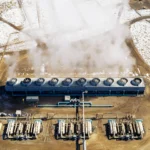Energy News Beat
Earlier this month, one corner of the internet got a little bit greener, thanks to a first-of-its-kind geothermal operation in the northern Nevada desert. Project Red, developed by a geothermal startup called Fervo, began pushing electrons onto a local grid that includes data centers operated by Google. The search company invested in the project two years ago as part of its efforts to make all of its data centers run on green energy 24/7.
Project Red is small—producing between 2 and 3 megawatts of power, or enough to power a few thousand homes—but it is a crucial demonstration of a new approach to geothermal power that could make it possible to harness the Earth’s natural heat anywhere in the world.
Hot rock is everywhere, with temperatures rising hundreds of degrees Fahrenheit within the first few miles of the surface, but geothermal plants provide just a small fraction of the global electricity supply. That’s largely because they are mostly built where naturally heated water can be easily tapped, like hot springs and geysers. Hot water is pumped to the surface, where it produces steam that powers turbines.
The Nevada site, an “enhanced” geothermal system, or EGS, works differently. Instead of drilling into a natural hydrothermal system, Fervo dug into rock that is completely dry and effectively created an artificial hot spring by pumping down water that returns to the surface much hotter.
That strategy piggybacks on hydraulic fracturing techniques developed by the oil and gas industry. Fervo drilled two wells that each extended more than 7,000 feet down before turning fully horizontal. It then connected them by fracking, producing cracks in the rock that connected the two boreholes. Water enters one borehole cold and exits the other at a temperature high enough to drive turbines and generate power.
Fervo announced that its experiment had been a success this summer after a monthlong testing period that saw temperatures at the bottom of the boreholes reach 375 degrees Fahrenheit (191 C) and enough water torrenting through the system to produce an estimated 3.5 megawatts of electricity. Those operational figures have held relatively steady since then, according to Fervo CEO Tim Latimer, suggesting the project was ready to be plugged into the grid for the long haul. The Nevada wells were drilled close enough to a traditional geothermal power plant that the project can use existing turbines and power lines to deliver electricity to the grid.
While output is short of the company’s initial 5-megawatt estimate when it announced with Google, Latimer says further tweaks should eke out more electricity in the future. As it stands, the project is the first to achieve such a high level of performance, he notes. While two plants in northeastern France currently produce electricity from dry rocks, they operate at substantially cooler temperatures and rely on exploiting natural fault systems in the rock. Latimer says that Fervo’s results point to a strategy that can be scaled up.
Geothermal energy could help Google with a challenge faced by all tech companies trying to reduce the impact of power-hungry data centers. Wind and solar now power vast swathes of the cloud computing behind internet services and apps, but because wind and sun aren’t always available, the flow of energy derived from them isn’t either.
Google has in recent years purchased enough renewable power to cover its data operations’ annual energy use—but at any given hour of the day, on any particular grid, the electricity that flows into a data center may have to come from a dirtier source. The company is now working on a more ambitious 2030 goal to secure 24/7 clean energy on the local grids where its data centers are located. Geothermal is a leading candidate for making it possible. “There’s a very small group of options there for technologies that we could scale,” says Michael Terrell, senior director for climate and energy at Google.
The company has explored other options, like new types of small-scale nuclear reactors or hydrogen fuel produced with renewable electricity, but they will likely take more time to develop. “Out of the next set of technologies after wind, solar, and lithium-ion storage, this is the first one that’s actually out there now delivering electrons,” Terrell says of the new Nevada geothermal plant. With an output of just a few megawatts of power, it’s a long way from providing the hundreds of megawatts a typical data center might need, but he considers the concept proven out.
Although it’s now up and running, EGS still has risks. The initial costs of any project are high, simply because reaching rocks that are hot enough requires drilling thousands of feet beneath the surface. The granite beneath places like the western US is considered ideal for EGS, because it provides relatively shallow heat and lacks natural fissures, meaning the only cracks into which the water will flow are those that engineers create. But the hard, tombstone-like rock is especially difficult to drill through.
Once the hard work of drilling the wells is over, there’s still a chance that an EGS project will never tap enough heat or pump enough water to power a plant. Sometimes it’s just not possible to properly read out what conditions will be like down there in advance. And some past EGS projects have accidentally triggered destructive earthquakes by disturbing natural faults.
Those challenges can dissuade investors, says Latimer, who are more interested in doling out small sums to exciting new lab technologies or more significant investments to more proven technologies, like solar. He describes technologies like EGS—theoretically feasible, but not yet proven at large scale—as the “missing middle” for energy investment.
Latimer says that Fervo has focused on reducing up-front drilling costs and mitigating the risk that a project will fail, primarily through modeling based on geological data to build an accurate picture of how the geothermal system it is creating will function. That work has been aided by the US government, which has funded a project called FORGE in Utah aimed at “derisking” EGS technology, primarily by testing out pricey tools and techniques like drill bits and seismic monitoring to see what works. The lessons are passed along to startups like Fervo.
Fervo’s next EGS project, in Beaver County, Utah, is scheduled to be operational in 2026 and will be far bigger than Project Red, at 400 megawatts. The location, visible from the FORGE site, was chosen for its well-understood geology and proximity to existing transmission lines. Latimer declined to give specific cost estimates for the electricity produced from the project, but he said the project is on track to match the costs of a traditional geothermal project, and all of its future energy production is already spoken for by utilities and other electricity customers. “We’re sold out!” he says—for now, at least. Latimer says the company is in the early stages of additional projects throughout the western US.
The post A New Type of Geothermal Power Plant Just Made the Internet a Little Greener appeared first on Energy News Beat.








